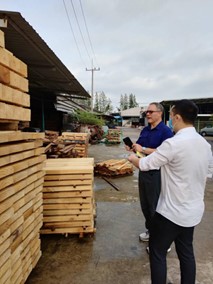With the loss of tens of million dollars in export sales to China, the U.S. wood industry is looking for alternative markets. That’s why Eric Gee, executive director of the Southern Forest Products Association, and Jerry Hingle, SFPA international consultant, traveled to Thailand in October for a wood seminar and trade opportunities mission.
Thailand is an attractive emerging market for Southern Pine as furniture manufacturers operating in China shift production to Thailand and elsewhere in Asia. Furniture production presents the best prospect for U.S. softwoods in Thailand, as much of the production there is exported to the U.S., Europe, and Japan, where buyers prefer softwood furniture compared to tropical hardwoods that appear “heavy” and dark.
However, the sustainability and legality of tropical woods in Thailand can be dubious, so using U.S. softwoods makes it considerably easier to prove sustainability and legal origin as the U.S. and Europe tighten regulations on the wood components used in imported furniture.
Other end-use opportunities, albeit to a lesser extent, include wood pallets, doors, and flooring. While more homebuilders are embracing imported softwoods for wood-frame homes, this is still considered a bit of a niche, as builders rely almost exclusively on concrete and steel.
Manufacturers typically source logs for processing at their facilities rather than lumber, as low average wages provide little incentive for large, well-financed operations to outsource finished lumber.
But lumber imports are growing, and what little softwood lumber they source is primarily supplied by New Zealand and, to a lesser extent, Canada and the U.S. Thailand imported just $622,000 of softwood lumber from the U.S. in 2022 but exports, including treated lumber, are up by 172% through September2023 over the previous year. Click here to see the latest export numbers.
 Gee spoke on Southern Pine lumber grades (descriptions and uses), sustainable forestry practices, and why wood is a smart climate choice, while Hingle presented on Southern Pine lumber characteristics, design considerations for areas prone to high wind and earthquakes, pressure-treated wood, and termite prevention.
Questions after the presentations centered around five key areas:
Gee spoke on Southern Pine lumber grades (descriptions and uses), sustainable forestry practices, and why wood is a smart climate choice, while Hingle presented on Southern Pine lumber characteristics, design considerations for areas prone to high wind and earthquakes, pressure-treated wood, and termite prevention.
Questions after the presentations centered around five key areas:
PROMOTING SOUTHERN PINE, SOFTWOODS IN THAILAND
The October 4-10 itinerary allowed Gee and Hingle to meet with prominent importers/traders for valuable insight into the current landscape of the wood industry, including learning about existing challenges and uncovering potential avenues for collaboration with SFPA. The duo had very productive and informative meetings with key lumber traders and specifiers at Interwood and CPD sawmill, BP Group Timber Processing Plant, and numerous furniture purveyors. As expected, numerous questions centered on lumber prices and the desire to procure logs instead of sawn lumber. Gee and Hingle also hosted a face-to-face seminar in Bangkok for 42 participants – more than any previous U.S. softwood lumber seminar in Thailand – who included lumber traders, architects, and furniture manufacturers. Gee spoke on Southern Pine lumber grades (descriptions and uses), sustainable forestry practices, and why wood is a smart climate choice, while Hingle presented on Southern Pine lumber characteristics, design considerations for areas prone to high wind and earthquakes, pressure-treated wood, and termite prevention.
Questions after the presentations centered around five key areas:
Gee spoke on Southern Pine lumber grades (descriptions and uses), sustainable forestry practices, and why wood is a smart climate choice, while Hingle presented on Southern Pine lumber characteristics, design considerations for areas prone to high wind and earthquakes, pressure-treated wood, and termite prevention.
Questions after the presentations centered around five key areas:
- How Southern Pine compares to domestic hardwoods.
- Preservatives used for pressure-treating and termite prevention.
- Environmental certification (one audience member added FSC certified wood is no longer in demand.
- Lumber prices and the continued desire to source logs instead of lumber.
- Preventing blue stain on imported logs.
